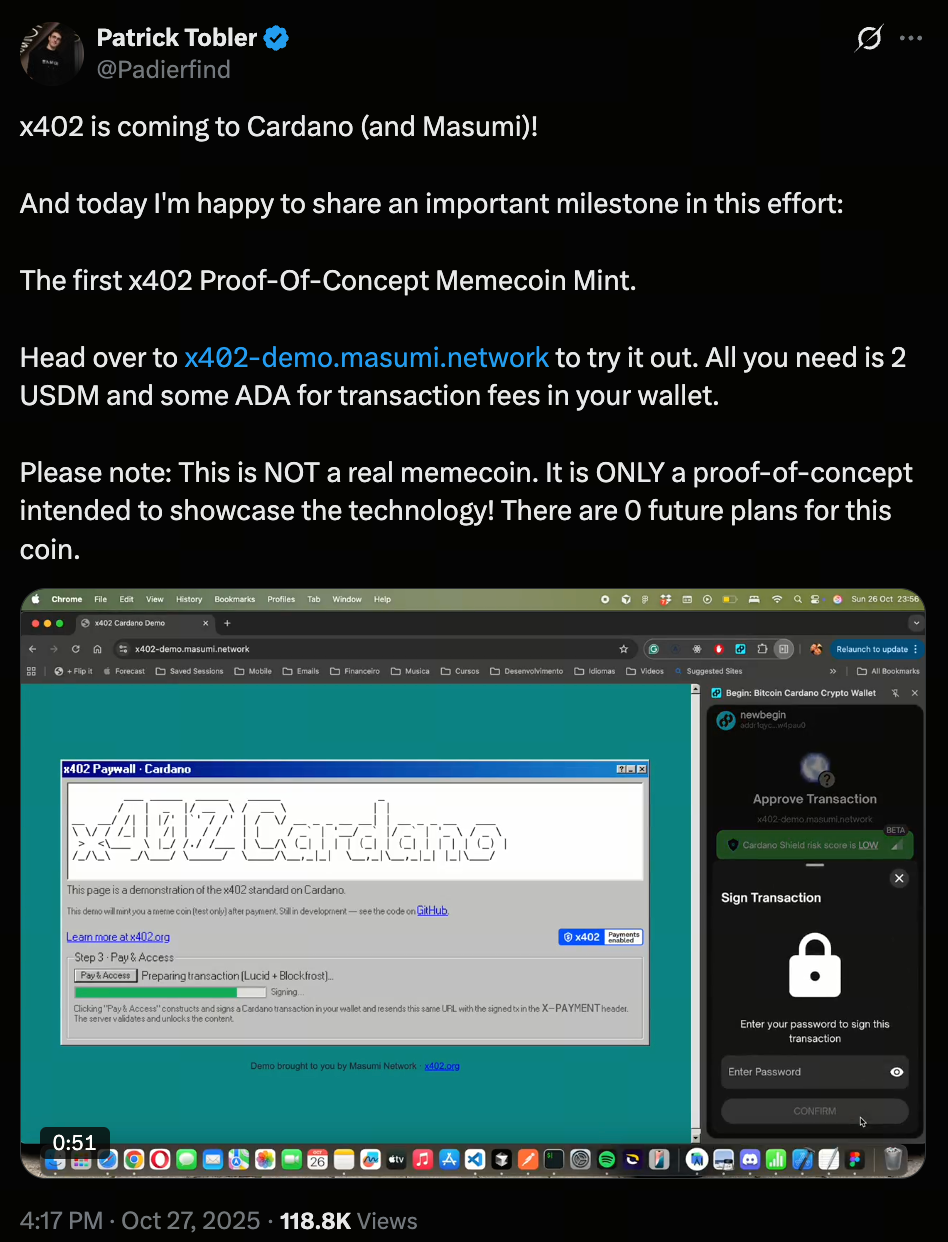Cardano’s Next Chapter: How x402 and Leios Consensus Usher in the Age of AI Payments
Preface
Recently, Patrick Tobbler, founder of NMKR and architect of Masumi Network, announced the official launch of the x402 protocol within the Cardano ecosystem and its deep integration with Masumi Network. This development has drawn significant attention from both the community and the industry, with Cardano founder Charles Hoskinson even stating on X (formerly Twitter): “This is an important step for Cardano.” This update represents more than just a technical upgrade—it signals the beginning of Cardano’s transition toward an AI-driven economic network.

(Source: Padierfind)
x402 Protocol: Redefining On-Chain Payment Logic
The x402 protocol draws inspiration from the HTTP 402 status code (“Payment Required”), but in the Web3 context, it is reimagined as a decentralized payment protocol layer. Unlike traditional payment flows, x402 enables users to pay for digital resources directly via API—no registration, email verification, or OAuth authorization required. Originally conceptualized by Coinbase and compatible with Google’s Agent-Payment Protocol (AP2), this technology marks a step toward the automation and standardization of on-chain payments.
Tobbler notes that the adoption of x402 provides Cardano with a native, verifiable, and automatically executable payment mechanism, establishing a reliable foundation for transactions between AI Agents. In essence, x402 is more than a payment protocol—it’s a financial infrastructure enabling autonomous operation of AI and the Web3 economy.
Masumi Network: Where AI Meets Blockchain
Masumi Network is an AI protocol layer built on Cardano, designed to enable secure transactions, verification, and task execution among AI Agents. With the integration of x402, AI Agents can now complete automated payments and resource exchanges without human intervention or centralized intermediaries, creating a truly trustless intelligent economy.
This architecture transforms Cardano from a mere smart contract platform into a collaborative infrastructure supporting the AI ecosystem. In future use cases, we may see AI agents autonomously purchase computing power, subscribe to data feeds, and even settle payments based on task outcomes—this is the vision unlocked by the synergy between Masumi and x402.
Leios Consensus: Cardano Scaling Moves Toward Engineering Implementation
Beyond foundational protocols, Cardano’s core consensus is undergoing a major evolution. The Input Output (IOG) team has announced that Ouroboros Leios has transitioned from theoretical research to engineering implementation, officially moving from Input Output Research (IOR) to Input Output Engineering (IOE). Leios is an advanced iteration of the existing Ouroboros consensus mechanism, primarily aimed at increasing transaction throughput and network scalability. Cardano is moving from theoretical design to a truly commercial-grade, high-speed network—laying the technical groundwork for large-scale AI payments and real-time interactions.
Why Are These Advancements Critical for Cardano?
These three advancements interact to create a virtuous cycle for Cardano’s technology, application landscape, and market positioning:
- Technical Advancement: x402 and Leios respectively reinforce Cardano’s payment and consensus layers, making it ideally suited for AI and Web3 applications.
- Ecosystem Transformation: The introduction of Masumi Network marks Cardano’s evolution from a blockchain platform to an AI collaborative infrastructure.
- Mainstream Adoption: The inclusion of ADA in US crypto ETFs demonstrates its emergence as a mainstream asset with enduring value.
If you want to explore more about Web3, click to register: https://www.gate.com/
Conclusion
From its origins as a smart contract platform to its current evolution into a multi-layered system integrating AI, payments, and consensus innovation, Cardano is entering a new era of openness and technical depth. With the deployment of the x402 protocol and Leios consensus, Cardano is advancing not only in on-chain finance but also in enabling the emergence of a self-operating AI economy. In the future, Cardano may transcend its role as just another public blockchain, becoming a smart economic network where humans and AI collaborate and participate together.
Related Articles

2025 BTC Price Prediction: BTC Trend Forecast Based on Technical and Macroeconomic Data

Flare Crypto Explained: What Is Flare Network and Why It Matters in 2025

Pi Coin Transaction Guide: How to Transfer to Gate.com

How to Use a Crypto Whale Tracker: Top Tool Recommendation for 2025 to Follow Whale Moves

What is N2: An AI-Driven Layer 2 Solution
